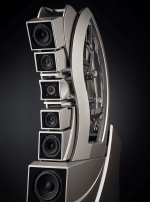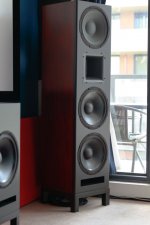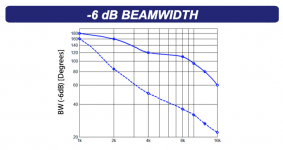I’ve noticed people having larger separation on ribbon tweeters than they “should” be using conventional parameters. I’m building a 3 way with either a tpl150 or a Raal most likely. If the math doesn’t work how is this calculated. My
Midrange is the TD8m and looking to cross 2500 -3000
Do you use c-c or to the edge of the ribbon
The woofer will be th TD15S ,H, or SBP. Haven’t quite nailed that down
Midrange is the TD8m and looking to cross 2500 -3000
Do you use c-c or to the edge of the ribbon
The woofer will be th TD15S ,H, or SBP. Haven’t quite nailed that down
Ideally any drivers being crossed from one to the other should be such that the driver to driver spacing is less than a quarter wavelength of the XO frequency.
Doing the math, without doing something tricky, you will find this a practical impossibility.
The further apart the drivers the smaller you make the sweet spot.
dave
Doing the math, without doing something tricky, you will find this a practical impossibility.
The further apart the drivers the smaller you make the sweet spot.
dave
Do you use c-c or to the edge of the ribbon
It's close to the "edge" for the ribbon and close to the center for the dynamic driver. The ribbon at lower freq.s (no beaming), the dyanamic driver at higher freqs (beaming).
You should have them as close as possible and with a low enough crossover freq.
The alternative to this is a focused array and an appropriate listener distance from the loudspeaker.
Ex.
Attachments
Center-center spacing between midrange and tweeter is used to calculate lobing.
Ribbons, or any other tall tweeter for that matter, are not special in the sense that they would allow a larger spacing.
Ribbons, or any other tall tweeter for that matter, are not special in the sense that they would allow a larger spacing.
Last edited:
-it can (vertically). It's all rather distance dependent so in this instance (focused array) the "sweet spot" isn't just a vertical and horizontal "measure", it's now also become substantively relating to listener distance from loudspeaker.
More than a few horn designs rely on this, and most of those are already vertically "narrow" for their sweet spot.
-with a few designs like the Wilson Audio: you can actually alter the image diffuse/stretch depending on listener distance (..derived by being a little farther back from the loudspeaker than optimal), which can be useful to achieve a more 3D image.
..it's all give and take. 😱
More than a few horn designs rely on this, and most of those are already vertically "narrow" for their sweet spot.
-with a few designs like the Wilson Audio: you can actually alter the image diffuse/stretch depending on listener distance (..derived by being a little farther back from the loudspeaker than optimal), which can be useful to achieve a more 3D image.
..it's all give and take. 😱
Last edited:
It's all rather distance dependent so in this instance (focused array) the "sweet spot" isn't just a vertical and horizontal "measure", it's now also become substantively relating to listener distance from loudspeaker.
With a focused array there is a narrow vertical window, usually some issues with horizontal and one has to be a fairly specific distance from the focused array (ie at the centre of the deign circle).
dave
I'm not even half as experienced as the folks that posted above, so take this with a grain of salt.
FWIW, I am experimenting with an MTM with TPL-150H and two 8PE21 crossing at 1500Hz and I listen at 2m away. It should produce lobbing, but frankly I haven't noticed it (sitting, standing up, walking around within the TPL 80° coverage). I intend to test higher xo points, but for now I'm looking into the midrange to midbass xo.
I thought hard about it for long time and ended up buying two 8" thinking MTM won't work, but also gave it a try and found I like it, so I'm getting an additional pair of 8". I will probably experiment with an inductor in between the midranges so that both are playing at the lower xo but only one is playing as it crosses over to the TPL.
cheers
I did look into TD8M and know it should allow a higher xo than the 8PE21, but past 2500Hz my guess is it will be too high. Experimentation will tell you, though.
FWIW, I am experimenting with an MTM with TPL-150H and two 8PE21 crossing at 1500Hz and I listen at 2m away. It should produce lobbing, but frankly I haven't noticed it (sitting, standing up, walking around within the TPL 80° coverage). I intend to test higher xo points, but for now I'm looking into the midrange to midbass xo.
I thought hard about it for long time and ended up buying two 8" thinking MTM won't work, but also gave it a try and found I like it, so I'm getting an additional pair of 8". I will probably experiment with an inductor in between the midranges so that both are playing at the lower xo but only one is playing as it crosses over to the TPL.
cheers
I did look into TD8M and know it should allow a higher xo than the 8PE21, but past 2500Hz my guess is it will be too high. Experimentation will tell you, though.
Appreciate all the replies. After much deliberation I’m going with the TD15S ,TD8M and the Tpl150.
Spoke with John and he recommended 2000hz on the 8-tpl so I’m starting there. Xo ont the 15Td will be 250-300hz. Deep water for me, hopefully it turns out correct. I’m sure I’ll have more questions if I can’t find in the search
Regards Jeff
Spoke with John and he recommended 2000hz on the 8-tpl so I’m starting there. Xo ont the 15Td will be 250-300hz. Deep water for me, hopefully it turns out correct. I’m sure I’ll have more questions if I can’t find in the search
Regards Jeff
In car with tweeters at ear level and midrange next to your feets works great, end results always depends on setup
Running an 8" midrange up to 2000 Hz and crossing it to a TPL150 tweeter is a serious compromise in terms of horizontal directivity. It will beam while the tweeter will not. A cheap 5" driver would be a better match and sound better, though it will not play as loud. Another option is to use the TPL150H, which has got a horn to limit horizontal dispersion to 80 degrees.
Last edited:
Too much of a generalization.
There is a huge range of different HF response characteristics of drivers of a certain size, dispersion largely controlled by come shape and the nature of the dustcap.
If one uses the primitive flat piston model, then yes, 8” will beam.
But has been done many times, an 8 can go high enuff to reach a tweeter,
dave
There is a huge range of different HF response characteristics of drivers of a certain size, dispersion largely controlled by come shape and the nature of the dustcap.
If one uses the primitive flat piston model, then yes, 8” will beam.
But has been done many times, an 8 can go high enuff to reach a tweeter,
dave
My original plan was to use a TD12 with the TD6M. John eluded the the TD8M would have a flatter response and the 15 would be a significant upgrade in dynamic impact. I’m not size or waf limited so I moved it up with both.
The TPLH 150 is what prompted me to question the possibility of such a design without crossing lower. I’m open to suggestions. Like to order all drivers in next few weeks
The TPLH 150 is what prompted me to question the possibility of such a design without crossing lower. I’m open to suggestions. Like to order all drivers in next few weeks
As suggested, the non-waveguide version is not symmetrical if you cross it around this suggested band, however a round driver would be axisymmetric. As a result there is no exact best place there to cross and you'll be relying on measured averages.
I swear someone crossed the tpl150 over at 700hz...crossed to a 12"....
I haven't seen it. Vapour Audio makes a 2-way with TPL-150H crossed at 1.1kHz to a 10". I haven't come across lower xo for this driver. Most people cross around 1.6kHz. There was a thread back some time ago where a resonance was measured around 1.8kHz so crossing at 2kHz seemed ideal from that point of view, but challenging to achieve with a large midrange and such large tweeter - at least on paper.
The non-H version, of course, requires a higher xo.
I recognize those (Vapour) maybe I confused them...1050hz XO is pretty low for the beymas as it is....
have you seen this?
DIY Front Soundstage build - 3-way Triple 12 Inch, Beyma TPL-150 AMT | AVS Forum
have you seen this?
DIY Front Soundstage build - 3-way Triple 12 Inch, Beyma TPL-150 AMT | AVS Forum
Attachments
I’ve noticed people having larger separation on ribbon tweeters than they “should” be using conventional parameters. I’m building a 3 way with either a tpl150 or a Raal most likely. If the math doesn’t work how is this calculated. My
Midrange is the TD8m and looking to cross 2500 -3000
Do you use c-c or to the edge of the ribbon
The woofer will be th TD15S ,H, or SBP. Haven’t quite nailed that down
Check out my article here:
What Causes Off-Axis Nulls?
Once you read that, consider this:
Yes, ribbons may allow for larger spacing.
Here's why:
In a two way loudspeaker, you get really strong nulls when you have one-wavelength-spacing. For instance, if you have a tweeter and a midbass and they're 25.4cm apart, you're going to have a deep null at 30 degrees off axis at 1350Hz. Even worse, there will be as much output directed to the ceiling and to the floor as to the listener! The reason that you have so much output radiating into the floor and into the ceiling is because the two drivers are in phase when:
1) you're in front of the speaker
2) and when you're 90 degrees above or below the speaker
As you can imagine, this is not a great thing. You don't want your speaker radiating all that energy into your floor and ceiling, it's going to ruin your imaging and intelligibility.
In order to deal with that, one solution would be to reduce the spacing from ONE wavelength to ONE HALF wavelength. For instance, if you raised your crossover point from 1350Hz to 2700Hz, there will be NO ENERGY going into the ceiling or the floor.
The reason that reducing the spacing reduces the radiation into the ceiling and into the floor is because the two drivers are now 180 degrees out of phase above and below the speaker, but they're perfectly in phase in FRONT of the speaker.
So far so good? If any of this is confusing, please let me know.
If you've made it this far into my boring post, let's talk about ribbons.
Everything that I said in the last few paragraphs is based on two drivers that have completely omnipolar radiation. IE, the two drivers radiate as much in FRONT of them as they radiate ABOVE and BELOW them.
But ribbons are very directional. For instance, it's not unusual to see ribbons that have as little as 10-30 degrees of vertical beamwidth.
If we agree that the main problem with one wavelength spacing is the fact that they generate a ton of output into the ceiling and the floor, then the use of a ribbon tweeter can be a valid solution to that. (Because a ribbon tweeter generates very little output into the ceiling and the floor.)
But before you run out and buy a ribbon tweeter, keep in mind that a new problem is introduced: you end up with a mismatch between the midbass and the ribbon. This is because the ribbon has NARROW vertical beamwidth, but the midbass has relatively wide vertical beamwidth. So you end up with a mismatch in the vertical beamwidth at the xover point. Is that the end of the world? You decide.
One thing that's worth considering is doing an MTM with a ribbon. Because a PAIR of midbasses can have narrow vertical beamwidth, matching the narrow vertical beamwidth of the ribbon tweeter.
Hope that makes sense, hit me up if it doesn't.
I’m open to suggestions.
1. Viawave
2. Lom165_vPA | .Kartesian
3. 2 woofers 16 ohms in parallel for 8 ohm load:
FaitalPRO | LF Loudspeakers | 12PR320 (16Ω)
The narrow vertical beamwidth of a Beyma TPL-150 actually only is there at higher frequencies. The data sheet shows this, be it quite general. The dotted line is (should be) the -6dB vs angle vs frequency curve.One thing that's worth considering is doing an MTM with a ribbon. Because a PAIR of midbasses can have narrow vertical beamwidth, matching the narrow vertical beamwidth of the ribbon tweeter.
Attachments
- Home
- Loudspeakers
- Multi-Way
- Ribbon spacing with midrange


